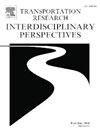Using computer vision and street-level videos for pedestrian-vehicle tracking and behaviour analysis
IF 3.9
Q2 TRANSPORTATION
Transportation Research Interdisciplinary Perspectives
Pub Date : 2025-03-01
DOI:10.1016/j.trip.2025.101366
引用次数: 0
Abstract
The extraction and exploitation of Surrogate Safety Measures (SSMs) have gained prominence in recent years, aided by rapid emerging technologies. SSMs can be applied in all aspects of safety, enabling new insights for analysing road user behaviour. In this context, this paper presents an integrated framework for tracking pedestrians and vehicles in complex urban environments, with a focus on analysing behaviours in relation to the traffic light status and the computation of the Time-to-Collision (TTC). Utilising advanced computer vision object detection and the feature extraction models of YOLOv8 and ResNet-50, this framework integrates Kalman filtering, homography transformations, and object re-identification to achieve high accuracy. The data used for this study were roadside video recordings from the Athens centre (Greece). Notably, the results show accuracy rates of 50 % to 70 % in detecting traffic light statuses and identified a 23 % discrepancy on average between manual and automated counts of illegal crossings. One of the key strengths and contributions of the study is the utilisation and transformation of street-level data provided by smartphone camera recordings, which emphasise the ease of transferability of the proposed approach without the requirements of specialised, costly, or heavy equipment. The analysis of pedestrian compliance, particularly during intergreen phases, provides novel knowledge on pedestrian behaviour and highlights opportunities to improve intersection design for safety. This study underscores the potential of computer vision detection systems to provide reliable, real-time data that takes the road network conditions into account, ultimately contributing to safer urban traffic management and informed policy decisions.
使用计算机视觉和街道视频进行行人车辆跟踪和行为分析
近年来,在快速发展的技术的帮助下,替代安全措施(SSMs)的提取和开发获得了突出的地位。SSMs可以应用于安全的各个方面,为分析道路使用者行为提供新的见解。在此背景下,本文提出了一个在复杂城市环境中跟踪行人和车辆的集成框架,重点分析与交通灯状态和碰撞时间(TTC)计算相关的行为。该框架利用先进的计算机视觉目标检测和YOLOv8和ResNet-50的特征提取模型,集成了卡尔曼滤波、单应变换和目标再识别,达到了较高的精度。本研究使用的数据是来自雅典中心(希腊)的路边录像。值得注意的是,结果显示,在检测交通灯状态方面的准确率为50%至70%,并且在人工和自动的非法越界次数之间发现了23%的平均差异。该研究的主要优势和贡献之一是利用和转换智能手机摄像头记录的街道数据,这强调了拟议方法的可转移性,而不需要专门的、昂贵的或重型设备。对行人合规性的分析,特别是在绿灯间阶段,提供了关于行人行为的新知识,并突出了改进十字路口安全设计的机会。这项研究强调了计算机视觉检测系统的潜力,它可以提供可靠的实时数据,将道路网络状况考虑在内,最终有助于更安全的城市交通管理和明智的政策决策。
本文章由计算机程序翻译,如有差异,请以英文原文为准。
求助全文
约1分钟内获得全文
求助全文
来源期刊

Transportation Research Interdisciplinary Perspectives
Engineering-Automotive Engineering
CiteScore
12.90
自引率
0.00%
发文量
185
审稿时长
22 weeks
 求助内容:
求助内容: 应助结果提醒方式:
应助结果提醒方式:


